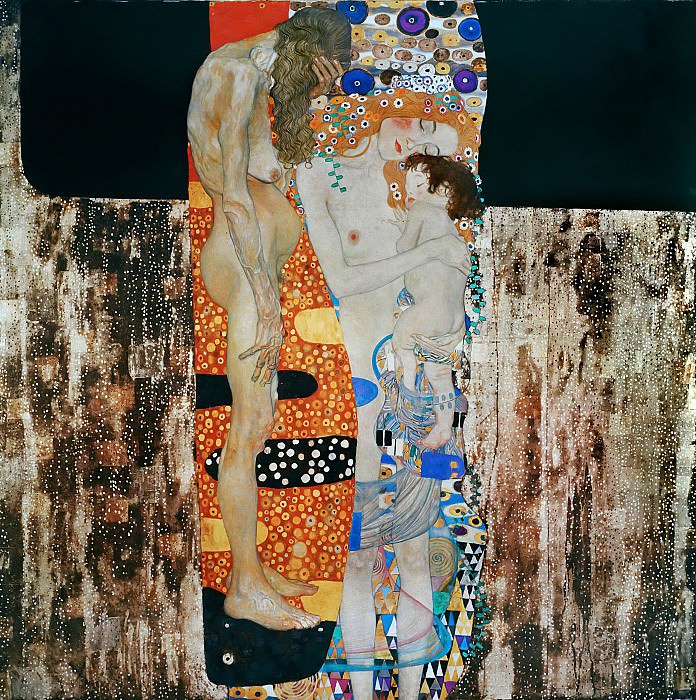The Three Ages of Woman Gustav Klimt (1862-1918)
Gustav Klimt – The Three Ages of Woman
Edit attribution
Download full size: 2100×2113 px (1,5 Mb)
Painter: Gustav Klimt
Location: National Gallery of Modern Art, Rome (Galleria Nazionale d’Arte Moderna).
The painting "Girls" by the famous Austrian artist of the early 20th century is better known to the narrow circle of extravagant art connoisseurs as "The Three Ages of Woman." The artist depicts three periods in the life of each woman in a manner peculiar to him alone, not at all shying away from depicting naked bodies and even saturating the picture with phallic symbols. On the right side of the picture is a baby girl, with her mother, a young girl in the prime of her life, embracing her.
Description of Gustav Klimt’s painting Girls
The painting "Girls" by the famous Austrian artist of the early 20th century is better known to the narrow circle of extravagant art connoisseurs as "The Three Ages of Woman." The artist depicts three periods in the life of each woman in a manner peculiar to him alone, not at all shying away from depicting naked bodies and even saturating the picture with phallic symbols.
On the right side of the picture is a baby girl, with her mother, a young girl in the prime of her life, embracing her. The characters are naked, but their nudity is so beautiful and enchanting that it evokes nothing but admiration.
On the left side of the canvas we can see an old woman who is also nude but far from beautiful. She covers her face with her hand and understands that her nudity is not beautiful at all. Her body has sunken in, her belly and breasts are sagging, and nothing reminds her of the beauty she had in her youth. The women are set against a backdrop of many small and quite large flowers, as if reclining on a carpet of flowers.
The painting refers to the last years of the artist’s life, the so-called "golden age" in the fate of the genius, the time when he goes on a trip to Venice, Ravenna and Florence and begins to write intensely. By the end of the journey he comes to the conclusion that his work is too full of detail and decides to pay more attention to the psychological side of painting. It is at this time that nude bodies appear on the canvases, drowning in flowers.
Floral paintings drove mad half of Vienna residents, every owner of the fashion salon sought to buy ready, or to order on your own choice, a picture of the eminent artist. The number of clients did not decrease until the beginning of the First World War, when the artist’s paintings lose their brightness and darken, reflecting the thoughts and feelings of the author about the war.
Кому понравилось
Пожалуйста, подождите
На эту операцию может потребоваться несколько секунд.
Информация появится в новом окне,
если открытие новых окон не запрещено в настройках вашего браузера.
You need to login
Для работы с коллекциями – пожалуйста, войдите в аккаунт (open in new window).




















COMMENTS: 1 Ответы
Репродукция неправильно расположена: женщина стоит, а на заднем плане есть еще одна фигура – старухи. Тогда становится понятно и название картины.
You cannot comment Why?
The figures are set against a backdrop of vibrant, patterned fabrics and abstract shapes. The old woman is partially obscured by a dark, textured area, perhaps symbolizing the fading of life or the unknown. The younger woman and child are on a more colorful and ornate section, filled with circles, dots, and floral motifs, representing life, vitality, and perhaps motherhood. The contrast between the starkness of the old woman and the richness surrounding the young woman and child highlights the passage of time and the changes that come with age.
The subtexts of the painting explore themes of life, death, love, and the cyclical nature of existence. The juxtaposition of youth and old age, life and potential sorrow, invites contemplation on the human experience. The mother and child symbolize nurturing, connection, and the continuation of life, while the aged woman may represent the inevitable march of time and the introspection that can accompany it. The elaborate ornamentation and use of gold leaf, characteristic of Klimts style, often imbue his works with a sense of beauty, sensuality, and even spirituality, suggesting that even in the face of aging and mortality, there is beauty and significance to be found in lifes journey.